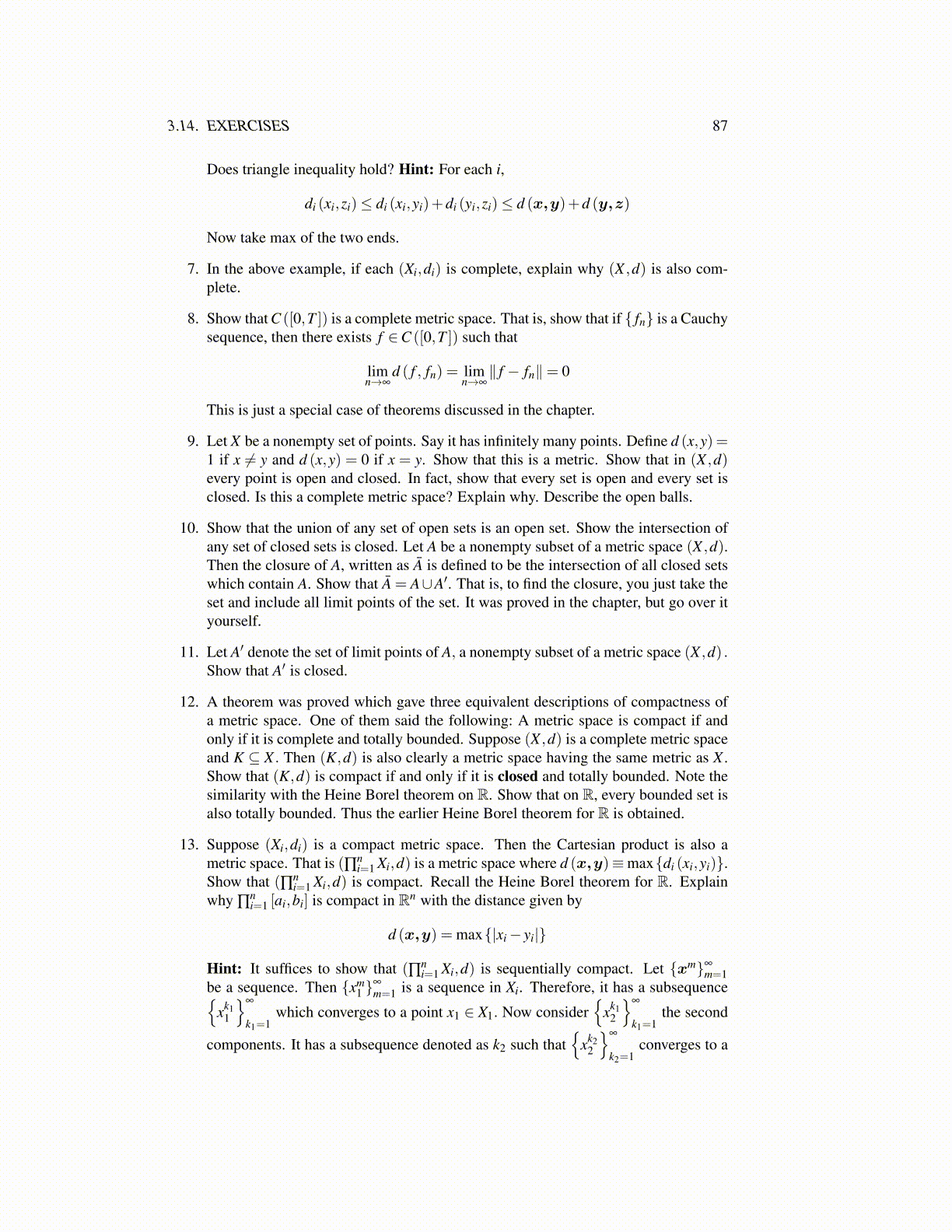
3.14. EXERCISES 87
Does triangle inequality hold? Hint: For each i,
di (xi,zi)≤ di (xi,yi)+di (yi,zi)≤ d (x,y)+d (y,z)
Now take max of the two ends.
7. In the above example, if each (Xi,di) is complete, explain why (X ,d) is also com-plete.
8. Show that C ([0,T ]) is a complete metric space. That is, show that if { fn} is a Cauchysequence, then there exists f ∈C ([0,T ]) such that
limn→∞
d ( f , fn) = limn→∞∥ f − fn∥= 0
This is just a special case of theorems discussed in the chapter.
9. Let X be a nonempty set of points. Say it has infinitely many points. Define d (x,y) =1 if x ̸= y and d (x,y) = 0 if x = y. Show that this is a metric. Show that in (X ,d)every point is open and closed. In fact, show that every set is open and every set isclosed. Is this a complete metric space? Explain why. Describe the open balls.
10. Show that the union of any set of open sets is an open set. Show the intersection ofany set of closed sets is closed. Let A be a nonempty subset of a metric space (X ,d).Then the closure of A, written as Ā is defined to be the intersection of all closed setswhich contain A. Show that Ā = A∪A′. That is, to find the closure, you just take theset and include all limit points of the set. It was proved in the chapter, but go over ityourself.
11. Let A′ denote the set of limit points of A, a nonempty subset of a metric space (X ,d) .Show that A′ is closed.
12. A theorem was proved which gave three equivalent descriptions of compactness ofa metric space. One of them said the following: A metric space is compact if andonly if it is complete and totally bounded. Suppose (X ,d) is a complete metric spaceand K ⊆ X . Then (K,d) is also clearly a metric space having the same metric as X .Show that (K,d) is compact if and only if it is closed and totally bounded. Note thesimilarity with the Heine Borel theorem on R. Show that on R, every bounded set isalso totally bounded. Thus the earlier Heine Borel theorem for R is obtained.
13. Suppose (Xi,di) is a compact metric space. Then the Cartesian product is also ametric space. That is (∏n
i=1 Xi,d) is a metric space where d (x,y)≡max{di (xi,yi)}.Show that (∏n
i=1 Xi,d) is compact. Recall the Heine Borel theorem for R. Explainwhy ∏
ni=1 [ai,bi] is compact in Rn with the distance given by
d (x,y) = max{|xi− yi|}
Hint: It suffices to show that (∏ni=1 Xi,d) is sequentially compact. Let {xm}∞
m=1be a sequence. Then {xm
1 }∞
m=1 is a sequence in Xi. Therefore, it has a subsequence{xk1
1
}∞
k1=1which converges to a point x1 ∈ X1. Now consider
{xk1
2
}∞
k1=1the second
components. It has a subsequence denoted as k2 such that{
xk22
}∞
k2=1converges to a